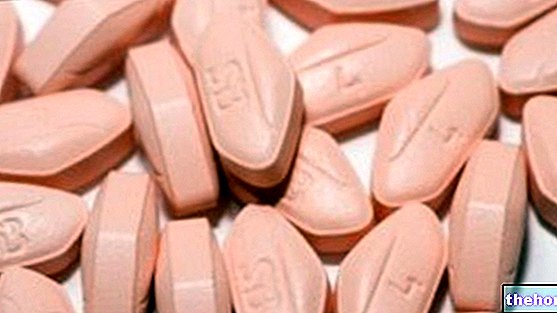ONGLYZA ® a Saxagliptin-based drug
THERAPEUTIC GROUP: Oral hypoglycemic agents - DPP-4 inhibitors

Indications ONGLYZA ® - Saxagliptin
ONGLYZA ® is used as a pharmacological aid for type 2 diabetic disease, in addition to metformin, sulfonylureas and PPAR gamma agonists, when single therapies have not produced the desired therapeutic effect.
Mechanism of action ONGLYZA ® - Saxagliptin
Saxagliptin, active principle of ONGLYZA ® is a selective inhibitor of DPP-4, enzymes responsible for the irreversible degradation of incretins (GLP-1 and GIP), gastro-intestinal hormones capable of modulating pancreatic activity, increasing the activity of beta cells, resulting in an increase in insulin concentrations, and sensitizing the alpha ones, with a reduction in the secretion of glucagon, which is responsible for the endogenous production of glucose.
From the metabolic point of view, both effects translate into a significant drop in glycemic levels, given by the doubling of blood concentrations of incretin, induced by saxagliptin.
Taken orally, this active ingredient reaches its maximum plasma concentration around the third hour, exerting the inhibitory action of DPP-4 for about 24 hours and is subsequently metabolized also in the liver into modestly active metabolites, eliminated mainly through the urine.
Modest variations in drug exposure have been observed in patients with impaired hepatic and renal function, for whom medical supervision is strictly necessary.
Studies carried out and clinical efficacy
1. THE EFFECTIVENESS OF COMBINED THERAPY
Diabetes Obes Metab. 2011 Feb 22. doi: 10.1111 / j.1463-1326.2011.01385.x.
Initial combination therapy with saxagliptin and metformin provides sustained glycaemic control and is well tolerated for up to 76 weeks.
Pfützner A, Paz-Pacheco E, Allen EM, Frederich B, Chen R.
Treatment of the second type diabetic patient with saxagliptin / metformin combined therapy ensured excellent glycemic control, reducing glycosylated hemoglobin concentrations by approximately 2 percentage points in 76 weeks of treatment, without clinically relevant side effects. The results obtained were much better than single therapies.
2. WHICH INHIBITOR TO USE?
Diabetes Res Clin Pract. 2010 Nov; 90: 131-40. Epub 2010 Aug 13.
DPP-4 inhibitors: what may be the clinical differentiators?
Gerich J.
The recent development of numerous active ingredients able to inhibit the DPP-4 enzyme, and the experimentation of even new ones, requires a control and algorithms useful to the doctor in the correct prescription of the drug. It is therefore important that there are lines guides, who can help the specialist in formulating the correct therapeutic plan, safeguarding the patient's health and increasing the effectiveness of the therapy.
3. SAXAGLIPTIN, NOT ONLY HYPOGLYCEMISING
Diabetes Metab Syndr Obes. 2010 May 10; 3: 117-24.
New treatments in the management of type 2 diabetes: a critical appraisal of saxagliptin.
Gallwitz B.
The treatment of second type diabetic pathology with Saxagliptin has proved useful not only in improving some markers of glucose metabolism such as glycosylated hemoglobin and fasting and postprandial glycaemia, but also in modulating and reducing cardiovascular risk.
Method of use and dosage
ONGLYZA ® saxagliptin 5 mg tablets:
the recommended dosage is one tablet than, taken regardless of meals, in combination therapy with metformin, thiazolidinediones or sulfonylureas.
Although the aforementioned dosage is the most recommended, it is of fundamental importance that your doctor organizes the correct therapeutic plan based on the physio-pathological characteristics of the patient, his metabolic situation and the possible intake of other drugs.
ONGLYZA ® Warnings - Saxagliptin
Pharmacological therapy with ONGLYZA ® should be supported and accompanied by non-pharmacological measures such as a balanced diet and a healthy lifestyle, useful for combating diabetic pathology.
Close medical supervision is necessary in patients with impaired renal or hepatic function, treated with sulfonylureas, given the risk of hypoglycaemia, and in elderly patients.
ONGLYZA ® contains lactose, therefore administration in patients with lactase enzyme deficiency, lactose intolerance or glucose / galactose absorption deficiency, could be accompanied by the concomitant onset of side effects concentrated especially at the gastrointestinal level.
The risk of hypoglycaemia, particularly evident in the case of concomitant intake of sulfonylureas, could make the use of machinery and the driving of motor vehicles dangerous.
PREGNANCY AND BREASTFEEDING
The use of ONGLYZA ® is not recommended in the treatment of gestational diabetes, given the absence of clinical studies capable of testing the safety profile of the drug on the health of the fetus, and given the possibility of using better characterized drugs.
ONGLYZA ® should also not be taken in the subsequent lactation phase, given the possibility of finding the active ingredient in breast milk, potentially dangerous for the health of the infant.
Interactions
Although the number of clinically significant interactions is low, pharmacokinetic changes affecting saxagliptin are described following the concomitant intake of diltiazem, ketoconazole, and rifampicin, potent drugs modulating the CYP3A4 enzyme system, responsible for the metabolism of saxagliptin.
Contraindications ONGLYZA ® - Saxagliptin
ONGLYZA ® is contraindicated in case of hypersensitivity to the active substance or to one of its components and during the period of breastfeeding and pregnancy.
This medicine should not be used for the treatment of first type diabetic patients or diabetic keto acidosidiabetic patients, much less in patients with impaired liver and kidney function.
Undesirable Effects - Side Effects
The data relating to the safety profile of saxagliptin essentially derive from the clinical trial, which tested this active ingredient on more than 3000 patients.
Although the therapy was well tolerated, among the most common adverse reactions, infections affecting the upper respiratory tract, headache and dizziness, vomiting, diarrhea and constipation, and peripheral edema were observed both in monotherapy and in combination therapy.
More serious clinical pictures were observed only in rare cases, and in patients hypersensitive to the active substance, while episodes of hypoglycaemia were mainly described following the combined intake of saxagliptin and glibenclamide.
Note
ONGLYZA ® can only be sold under strict medical prescription.
The information on ONGLYZA ® - Saxagliptin published on this page may be out of date or incomplete. For a correct use of this information, see the Disclaimer and useful information page.









.jpg)


















